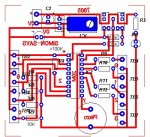I have changed the code with 'loop' to 'push' as I was aware of this glitch.
I was not aware of the changing preload 0 -100 to 30. I am not completely sure of what each section does or the intricacies of the chips memory allocations etc...
BUT
Thank you so much it now works. I messed up a bit with the board with the variable speed part but i have soldered a 100K resistor to + and 10K to Ov to stabilise the speed as a potential divider and the speed is fixed at a good level now.
I have included my PCB and finished code.
Many thanks for the help guys
Absolutely Fabulous support
Chris
‘ AXE106 Simon Says Game for 20M
‘ *** Define the variables used ***
‘ Push switches on inputs 0,1,6,7
‘ Speed preset on input 2
‘ LEDs on outputs 0-3
‘ Piezo on output 7
symbol rand = b1 ‘ random number store for loading memory
symbol value = b2 ‘ switch value 0-1-2-3
symbol playerstep = b3 ‘ position of player in game
symbol freq = b4 ‘ sound variable
symbol topstep = b5 ‘ number of steps in sequence
symbol counter = b6 ‘ general purpose counter
symbol speed = b7 ‘ speed
‘ *** Section 1 **********************
‘ *** This section waits for start ***
‘ ************************************
‘ wait for any switch to be pushed
‘ with all four LEDs lit
‘ preload rand with any number by repeatedly
‘ using the random command in the loop
init:
let pins = %00001111
random rand
if pin0 = 1 then preload
if pin1 = 1 then preload
if pin6 = 1 then preload
if pin7 = 1 then preload
goto init
‘ *** Section 2 ****************************
‘ *** This section loads memory for game ***
‘ ******************************************
‘ load EEPROM data memory with 100 numbers
‘ first get the random number (0 to 255)
‘ and then change to either 1,2,3 or 4
‘ and then save into data memory
preload:
let pins = %00000000 ‘ LEDs off
for counter = 0 to 30 ‘ for..next loop
let value = 0
random rand ‘ get random number 0-255
if rand > 180 then set0
if rand > 120 then set1
if rand > 60 then set2
set3: let value = value + 1 ‘1+1+1 = 3
set2: let value = value + 1 ‘1+1 = 2
set1: let value = value + 1 ‘1
set0: ‘0
write counter,value ‘ save in data memory
next counter ‘ next loop
‘ *** Section 3 ****************************
‘ *** This section plays back a sequence ***
‘ ******************************************
‘ switch off the LEDs and then start
‘ a game with the end counter as 1
let pins = %00000000 ‘ LEDs off
let topstep = 1 ‘ reset step number to 1
‘ playback the game sequence
playback:
readadc 2,speed ‘ read speed value
for counter = 1 to topstep ‘ for...next loop
read counter,value ‘ get value
gosub beep ‘ make the noise
pause 300 ‘ short delay
next counter ‘ loop
‘ *** Section 4 *****************************************
‘ *** This section detects the players reply sequence ***
‘ *******************************************************
‘ now the user responds
‘ reset the players position to 1
playerstep = 1
gameloop:
‘ if playerstep is greater than topstep then all done
if playerstep > topstep then success
‘ get the correct key value is supposed to hit
‘ from the EEPROM memory
read playerstep,value
‘ now wait for switch to be pressed
push: if pin7 = 1 then pushed0
if pin6 = 1 then pushed1
if pin1 = 1 then pushed2
if pin0 = 1 then pushed3
goto push
‘ switch pressed so check it is the correct one
‘ if it is make a beep sound and then continue
‘ else fail the game
pushed0:
if value <> 0 then fail
let playerstep = playerstep + 1
gosub beep
goto gameloop
pushed1:
if value <> 1 then fail
let playerstep = playerstep + 1
gosub beep
goto gameloop
pushed2:
if value <> 2 then fail
let playerstep = playerstep + 1
gosub beep
goto gameloop
pushed3:
if value <> 3 then fail
let playerstep = playerstep + 1
gosub beep
goto gameloop
‘ *** Failed so make noise and jump back to start ***
‘ failed so make failed noise, switch off all LEDs
‘ and go back to start
fail:
let pins = %0000000 ‘ all LEDs off
sound 7,(80,100) ‘ make a noise
sound 7,(50,100)
goto init ‘ back to start
‘ *** Succeeded so add another step to sequence and loop ***
‘ success so make a success sound
‘ and then increment topstep and do another sequence
success:
pause 100 ‘ short delay
let pins = %00001111 ‘ all LEDs on
sound 7,(120,50) ‘ success beep
let pins = %00000000 ‘ all LEDs off
pause 100 ‘ short delay
let topstep = topstep + 1 ‘ add another step
goto playback ‘ loop again
‘ *** Section 5 ****************
‘ *** sub light LED and beep ***
‘ ******************************
‘sub-procedure to light correct LED
‘and make a different beep sound for each LED
‘value always contains number 0,1,2 or 3.
‘add 1 and multiply by 20 to give larger difference
‘in the sound noise
beep:
high value ‘ switch on LED
freq = value + 1 ‘ generate sound freq.
freq = freq * 25
sound 7,(freq,speed) ‘ play sound
low value ‘ switch off lED
return ‘ return

